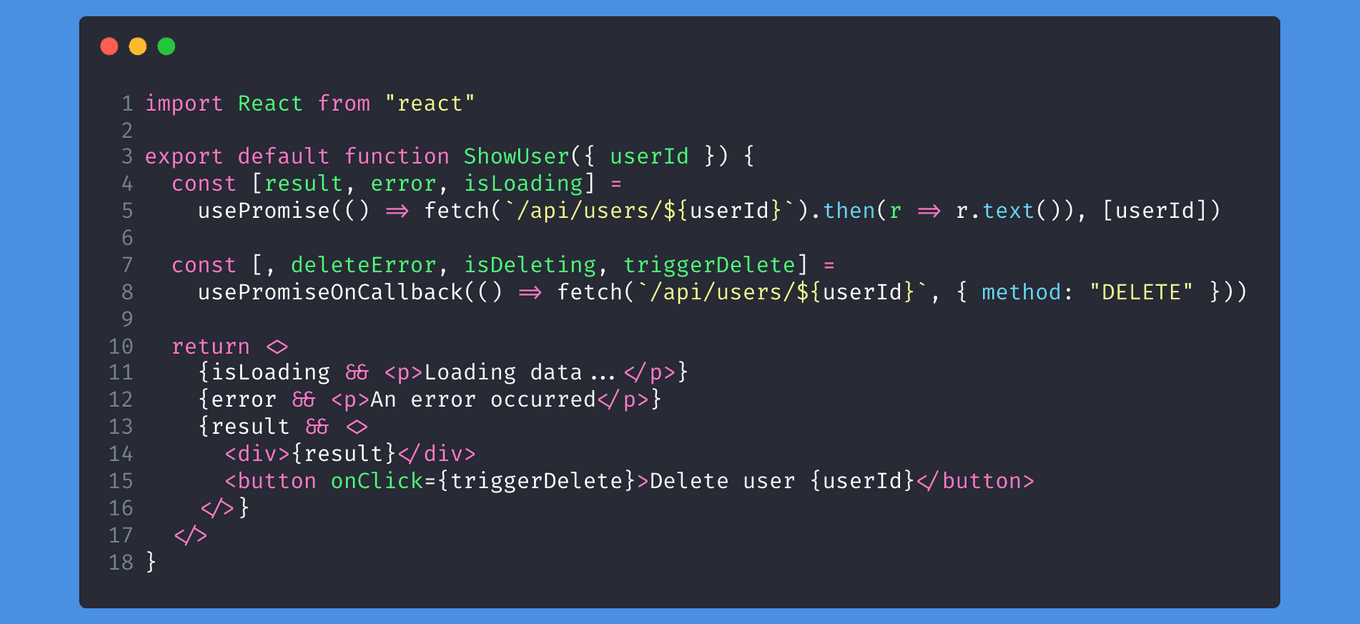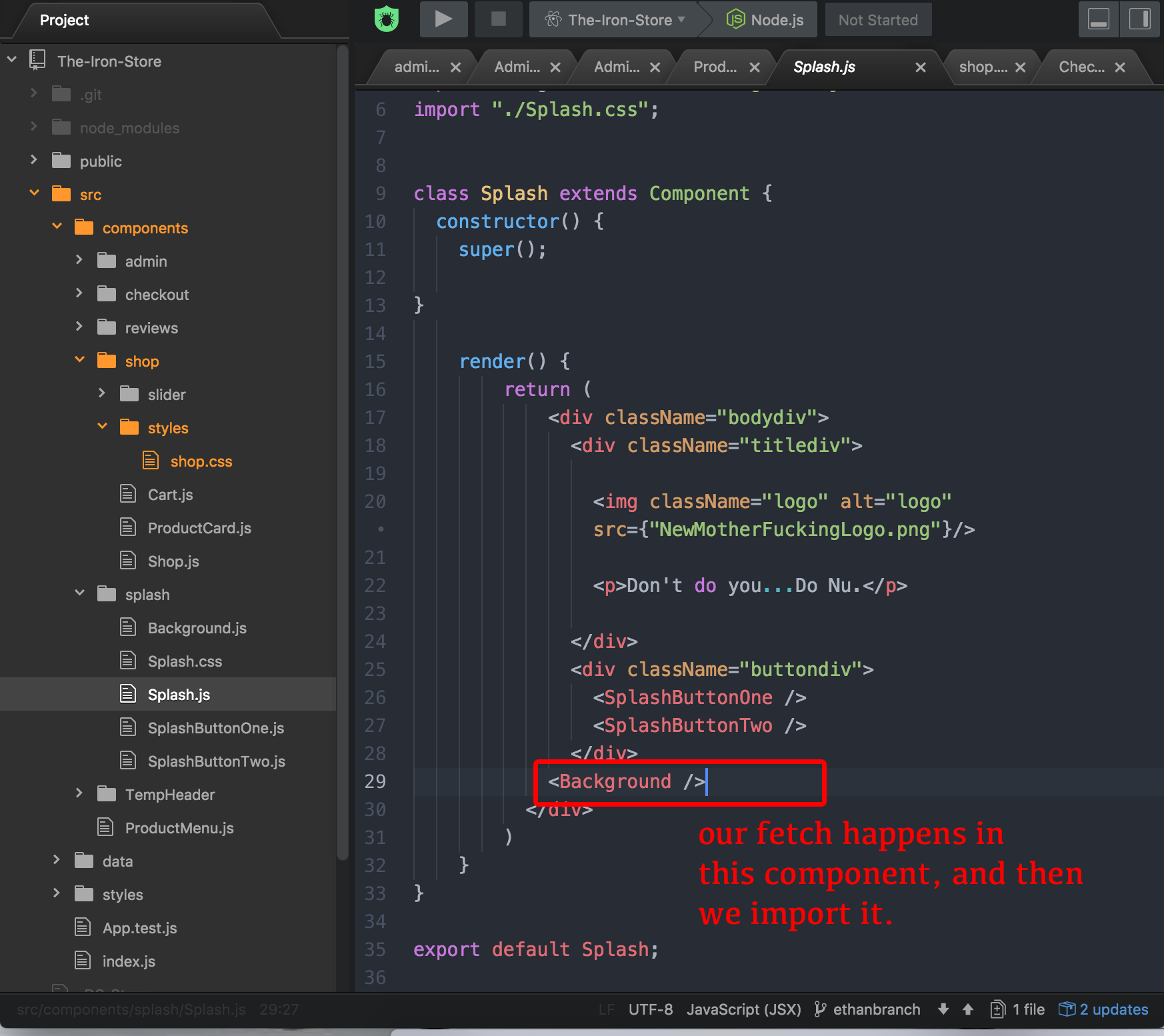

So far, we know quite a bit about fetch.
The Fetch API provides a fetch method defined on the window object, as well as a JavaScript interface for accessing and manipulating HTTP requests and responses. Fetch has only one mandatory argument: the URL of the resource to be fetched. It returns a promise that can be used to retrieve the response of the request. Without any doubt, the use of React is increasing day by day. And also API(Application Programming Interface) is gaining more popularity in the modern era of technology. The masterplan 1 2 2. This article will guide a beginner to play with React to API. Assume that we want to fetch a list of pictures when a page gets loaded.
Let’s see the rest of API, to cover all its abilities.
Please note: most of these options are used rarely. You may skip this chapter and still use fetch well.
Still, it’s good to know what fetch can do, so if the need arises, you can return and read the details.
Here’s the full list of all possible fetch options with their default values (alternatives in comments):
An impressive list, right?
We fully covered method, headers and body in the chapter Fetch.
The signal option is covered in Fetch: Abort.
Now let’s explore the remaining capabilities.
These options govern how fetch sets the HTTP Referer header.
Usually that header is set automatically and contains the url of the page that made the request. In most scenarios, it’s not important at all, sometimes, for security purposes, it makes sense to remove or shorten it.
The referrer option allows to set any Referer (within the current origin) or remove it.
To send no referer, set an empty string:
To set another url within the current origin:
The referrerPolicy option sets general rules for Referer.
Lock mac with touch bar. Requests are split into 3 types:
Unlike the referrer option that allows to set the exact Referer value, referrerPolicy tells the browser general rules for each request type.
Possible values are described in the Referrer Policy specification:
Here’s a table with all combinations:
| Value | To same origin | To another origin | HTTPS→HTTP |
|---|---|---|---|
| 'no-referrer' | - | - | - |
| 'no-referrer-when-downgrade' or ' (default) | full | full | - |
| 'origin' | origin | origin | origin |
| 'origin-when-cross-origin' | full | origin | origin |
| 'same-origin' | full | - | - |
| 'strict-origin' | origin | origin | - |
| 'strict-origin-when-cross-origin' | full | origin | - |
| 'unsafe-url' | full | full | full |
Let’s say we have an admin zone with a URL structure that shouldn’t be known from outside of the site.
If we send a fetch, then by default it always sends the Referer header with the full url of our page (except when we request from HTTPS to HTTP, then no Referer). Undertale apk ios.
E.g. Referer: https://javascript.info/admin/secret/paths.
If we’d like other websites know only the origin part, not the URL-path, we can set the option:
We can put it to all fetch calls, maybe integrate into JavaScript library of our project that does all requests and uses fetch inside.
Its only difference compared to the default behavior is that for requests to another origin fetch sends only the origin part of the URL (e.g. https://javascript.info, without path). For requests to our origin we still get the full Referer (maybe useful for debugging purposes).
Referrer policy, described in the specification, is not just for fetch, but more global.
In particular, it’s possible to set the default policy for the whole page using the Referrer-Policy HTTP header, or per-link, with <a>.
The mode option is a safe-guard that prevents occasional cross-origin requests:
This option may be useful when the URL for fetch comes from a 3rd-party, and we want a “power off switch” to limit cross-origin capabilities.
The credentials option specifies whether fetch should send cookies and HTTP-Authorization headers with the request.
Profind 1 7 2 x 2. By default, fetch requests make use of standard HTTP-caching. That is, it respects the Expires and Cache-Control headers, sends If-Modified-Since and so on. Just like regular HTTP-requests do.
The cache options allows to ignore HTTP-cache or fine-tune its usage:
Normally, fetch transparently follows HTTP-redirects, like 301, 302 etc.
The redirect option allows to change that:

The integrity option allows to check if the response matches the known-ahead checksum.
As described in the specification, supported hash-functions are SHA-256, SHA-384, and SHA-512, there might be others depending on the browser.
For example, we’re downloading a file, and we know that it’s SHA-256 checksum is “abcdef” (a real checksum is longer, of course). Findings 2 0 4 – lab notebook app for scientists.
We can put it in the integrity option, like this:
Then fetch will calculate SHA-256 on its own and compare it with our string. In case of a mismatch, an error is triggered.
The keepalive option indicates that the request may “outlive” the webpage that initiated it.
For example, we gather statistics on how the current visitor uses our page (mouse clicks, page fragments he views), to analyze and improve the user experience.
When the visitor leaves our page – we’d like to save the data to our server. Safari extensions ios.

We can use the window.onunload event for that:
Normally, when a document is unloaded, all associated network requests are aborted. But the keepalive option tells the browser to perform the request in the background, even after it leaves the page. So this option is essential for our request to succeed. Animal crossing pocket camp server maintenance.
It has a few limitations:
